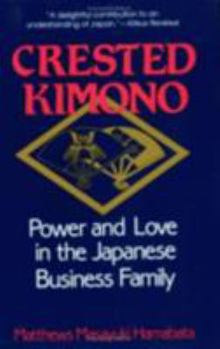The Crested Kimono: The World Beneath Paris and London, 1800-1945
Select Format
Select Condition 
Book Overview
Matthews Hamabata got off to an unpromising start when he first arrived in Japan to study influential business families. An unmarried, third-generation Japanese-American graduate student, he was there to learn about business executives in their roles as male principals and heads of households. Some Japanese were less than hospitable and often downright rude to him, and the souvenirs bearing the Harvard University emblem that he had brought along for gifts proved to be inappropriate within the highly ritualized system of Japanese gift-giving.
In this engaging and personal narrative, we watch Hamabata in the first disappointing six months of his fieldwork as he attempts to map the boundaries of culture, class, and sexuality. "I became my own biggest fieldwork problem," he writes. "Was I inside or out? When I thought I was in, I was actually out, but when I acknowledged the fact that I was out, I was let in." He soon recognized the importance of marital and filial relations in transmitting power in the business world, and he began to direct his study to examining the social and emotional lives of all members of the Japanese ie (household) and the way they affect business activity and ownership. He takes us behind the scenes of the family enterprise to see how the multiple "layers of reality"--biological, social, religious, emotional, and symbolic--relate and cause dilemmas for ie members. (Names, locations, and other details have been altered for the sake of anonymity.)
We meet the Moriuchis, the Itoos, the Okimotos--people who must constantly balance their own personal desires against the good of the ie. Many telling vignettes illustrate a central tension in their lives--their need for love, power, and emotional expression versus the constraints of traditional attitudes toward their ancestors, public honor, the economic enterprise, and the obligation to continue the ie over time. A grandfather stubbornly refuses to hand over the reins of succession to the next generation, creating an impossible situation that eventually tears apart an economic empire, as well as the fabric of various interrelated families. Economic, familial, and religious factors figure in a clash for succession between the person who possesses the ancestral tablets and the head of the enterprise. A daughter must reconcile personal love with arranged marriage. Ambitions for the son in line for succession war with the realization that this spoiled, incompetent young man may well ruin the ie.
A fascinating portrait of everyday life told with vibrant sensitivity as well as humor, this book is full of the vitality of common concerns: life choices, love and commitment, confrontations with death. It is about very real people trying to make sense of their lives--trying to reconcile the roles and duties dictated by custom and tradition with rapidly changing expectations in the international milieu of contemporary Japan.
Related Subjects
Accounting & Finance Anthropology Business Business & Finance Business & Investing Cultural Economics Entrepreneurship History International Marriage & Family Parenting & Relationships Politics & Social Sciences Small Business & Entrepreneurship Social Science Social Sciences Sociology




